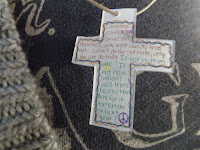I may be one of the few people in Baltimore who didn’t actually see last Sunday's play-off game against the Patriots. I was flying home from Boston (at least I was heading in the right direction!) and only caught the last 2/3’s of the last quarter—the heartbreaking part.
So all week long I’ve been moping and commiserating with my fellow Baltimoreans. We’ve been sharing our shell shock over the disappointing defeat. It wasn’t just the end of game Lee Evan’s dropped pass (that looked like a completed pass and never got reviewed) or Billy Cundiff’s funky field goal miss after a heart stopping 90 yard drive down the field. It was the ref’s failure to place the ball on the 10 yard line to give us the 1st down that we deserved followed by his failure to call an obvious pass interference on the 10 yard line that should also have given us a fresh set of downs. You have to wonder.
 |
| Mighty Ravens enter the arena |
It’s the kind of loss that’s hard to shake off. You keep replaying those last few minutes in your head because it’s a game we should have won. Ultimately we outplayed them by almost every measure. As I finally get the time to watch the replay and see more missed penalty calls against the Patriots (off-sides, pass interference, helmet to helmet and holding)and watch Joe Flacco’s numbers eclipse Brady’s , a funny thing happens. My disappointment finally begins to erode and I move towards uplift. It isn’t just that time heals all wounds. I move towards a bigger picture. These are warriors, gladiators doing battle in a coliseum. We’ve come a long way from the lions, thumbs up for who lives and and thumbs down for who doesn't. Still something about the epic battle stirs us and vents our lust for combat. We spectators dress up for the spectacle, put on our favorite team member’s shirt and get a vicarious thrill while these gifted athletes amaze us with their feats of power, grace and endurance.
 |
| Touch Unitas' toe before the game |
So for the week leading up to the clash of titans, I watched with delight and amusement as Baltimore drowned in royal purple. People drove with flags fluttering, transforming ordinary sedans and trucks into zany escort vehicles. We were clearing the way for our champions, not third world despots. I saw tiny terriers dressed in ravens sweaters and grown men sporting stick-on Flacco purple felt mustaches. There seemed to be no limits to the absurdities we would submit to in order to demonstrate our solidarity, to reach across boundaries and say “We are all part of one big community, hoping for one great outcome together.” I even dug out purple beads , earrings and a ring to wear. Yes, when so many of our fellow citizens are hungry, homeless and unemployed, I do wish we could achieve the same passionate connection about something more important than winning a football game. But it shows that we can connect over something.
Every week when these men stepped out on the field whether at home or away, they carried something of us with them and we allowed them to. We wanted them to. Week after week, they suited up, went out onto the field and did their jobs. They gave us a great home season of one win after another. They elevated us, connected an entire city and gave complete strangers, men and women, adults and children, something to talk about in check out lines, in drug stores and restaurants. They turned casual armchair observers into serious amateur commentators who wondered who hired the professional ones to chatter incessantly about nothing. They helped us for a few short months through hope, effort , gathering and commitment to celebrate US.
But what I loved most is what they taught us about accountability. At the end of every game comes the ritual of talking to the press whether you win or lose. What I learned from watching our head coach, our quarterback and other players—most of whom are young enough to be my children—is that you take responsibility for your performance. It helps, of course, that everyone on national TV just saw what you did or didn’t do but our politicians and business leaders are under equally keen scrutiny and they don’t seem to have learned this very simple but crucial point. Harry Truman put it this way: “The buck stops here.” As president, he couldn’t avoid responsibility for big decisions or their consequences. What I observed week after week was the complete openness with which our players and coach entered the true lion’s den: the after game press conference and took total responsibility for their performance –even in this most heartrending of all games—the loss to the Patriots.
If they did well, it was because of the team effort. If they did badly, there were no excuses. “I messed up. I didn’t do what I was supposed to.” The buck stops here. Now THAT’S a lesson worth celebrating. Washington, are you listening?







